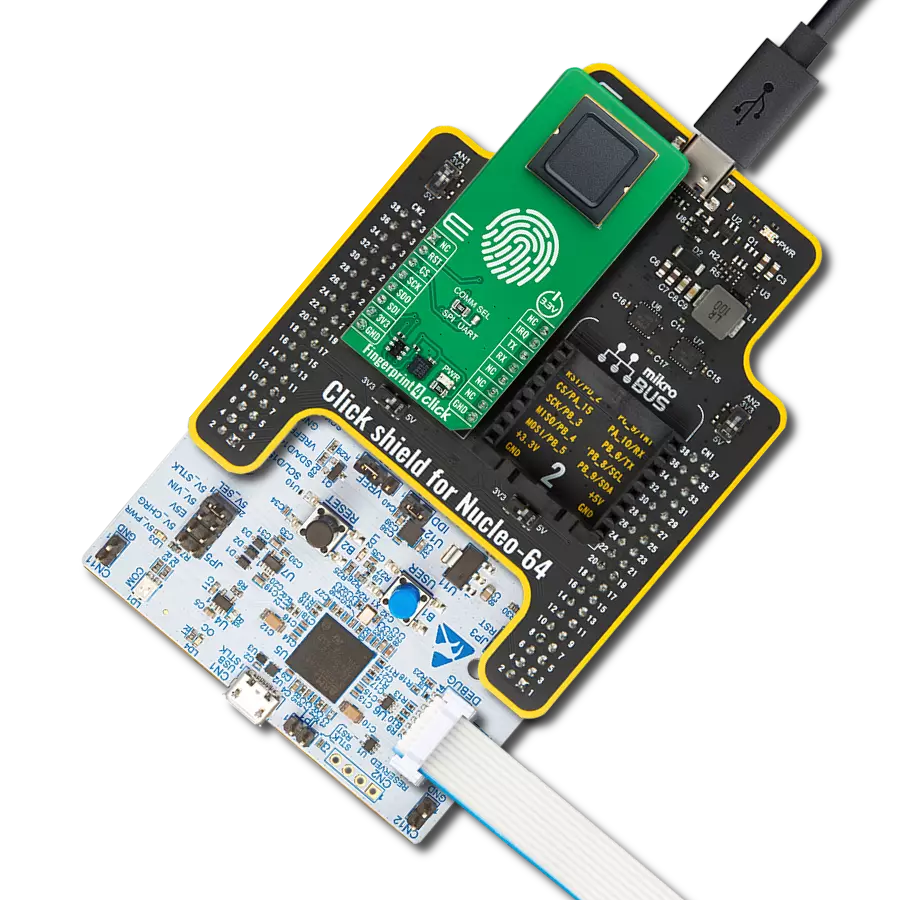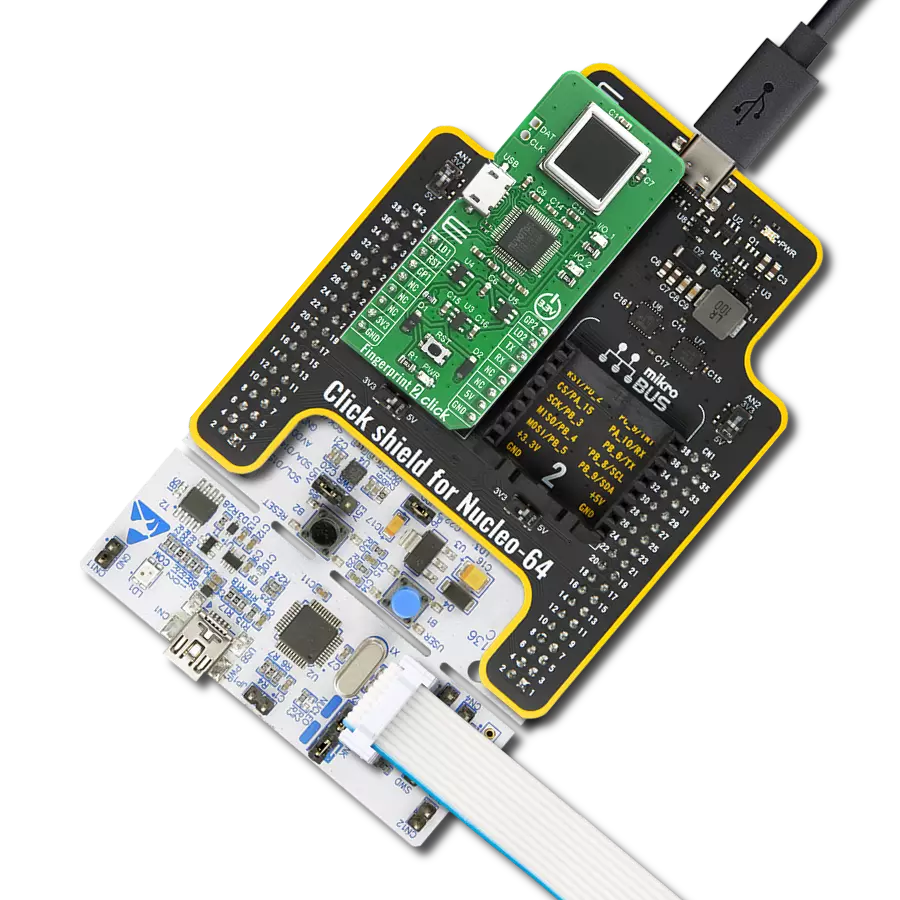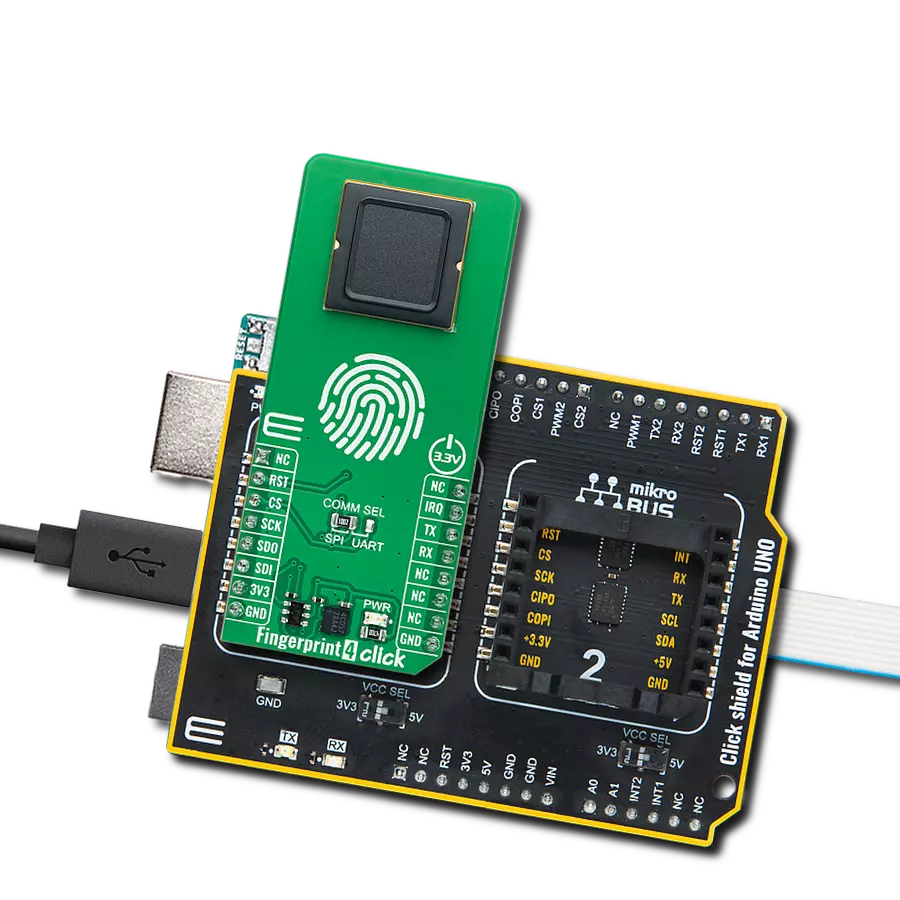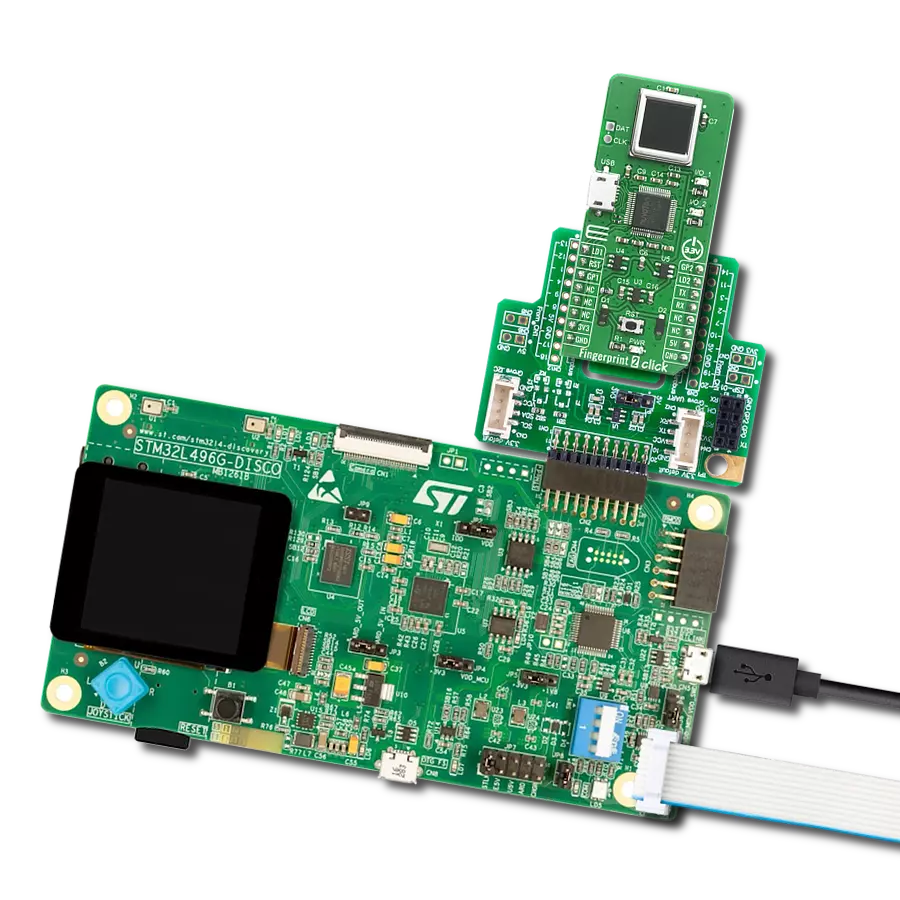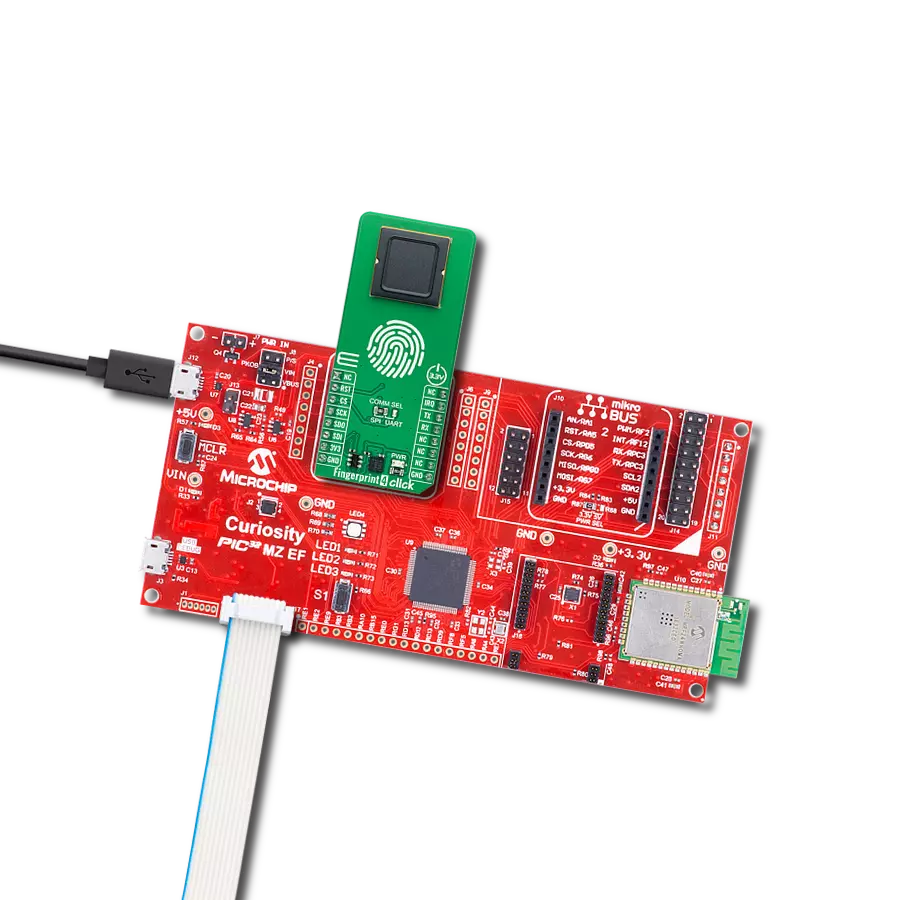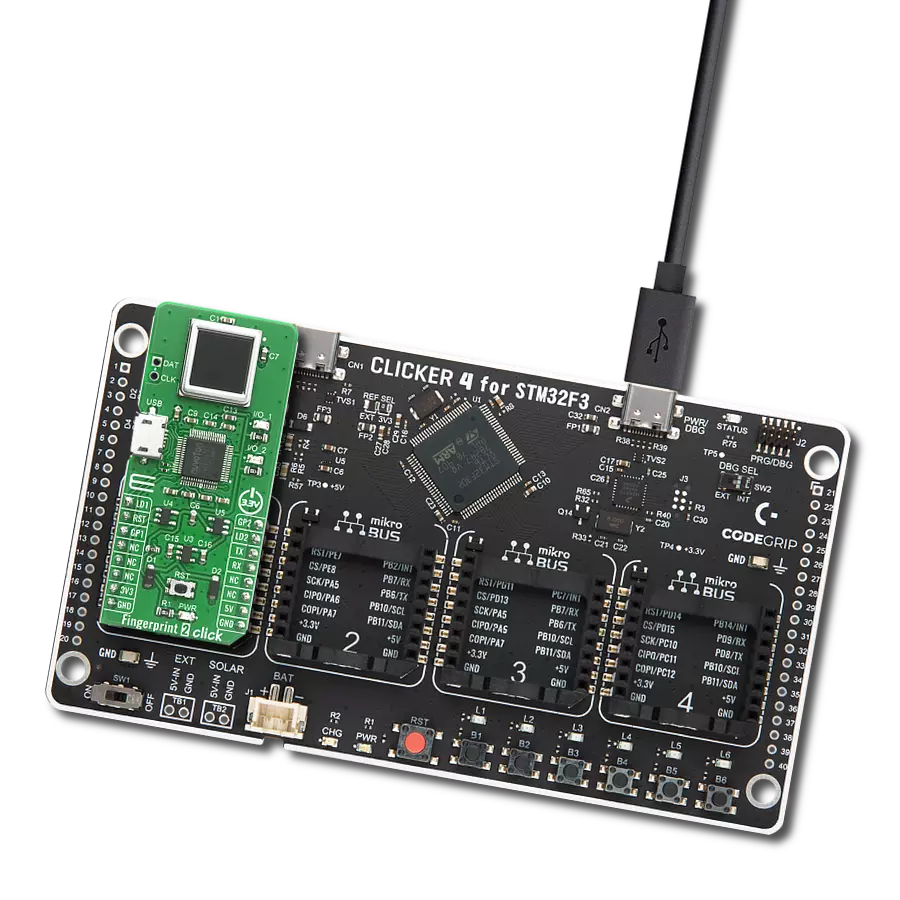该解决方案旨在提供实时匹配和验证指纹模式,建立无缝且强大的身份验证过程。
A
A
硬件概览
它是如何工作的?
Fingerprint 4 Click 基于 FPC BM-Lite 模块 (100018754),是一种来自 Fingerprints 的独立、紧凑的生物指纹解决方案,配备了强大的指纹传感器、生物处理器和即插即用的板载模板存储。此 Click board™ 可集成到任何应用中,通过可选的串行接口,由主 MCU 发送一些基本命令进行注册和验证。BM-Lite 模块基于电容技术,采用反射测量方法。它从指纹传感器获取指纹图像,并将其存储在预加载有 Fingerprints 固件的内部闪存中,用于所有生物操作和模板存储。BM-Lite 模块拥有
160x160 像素传感器矩阵,使用 3D 像素感应技术,可以读取干燥或潮湿的手指,结合卓越的生物性能和高标准的集成优质组件,提供增强安全性和用户便利性的嵌入式解决方案。该模块具有保护涂层,可防止 ±15kV ESD、划痕和日常磨损。它还防水,适用于苛刻的工业环境和全天候应用。Fingerprint 4 Click 允许使用默认配置为 115200bps 的 UART 接口,通过常用的 UART RX 和 TX 引脚与主 MCU 传输和交换数据,或使用最大频率为 20MHz 的 SPI 接口。选择可以通过将标记为 COMM
SEL 的 SMD 跳线定位在适当位置来完成。在使用 SPI 接口时,用户可以使用标记为 IRQ 并连接到 mikroBUS™ 插座的 INT 引脚的数据就绪引脚,通知主 MCU 检测到模块上的手指,并通过 RST 引脚执行一般复位功能。此 Click board™ 只能在 3.3V 逻辑电压水平下操作。在使用具有不同逻辑电平的 MCU 之前,必须执行适当的逻辑电压电平转换。此外,它还配备了一个包含函数和示例代码的库,可作为进一步开发的参考。
功能概述
开发板
PIC32MZ Clicker 是一款紧凑型入门开发板,它将 Click 板™的灵活性带给您喜爱的微控制器,使其成为实现您想法的完美入门套件。它配备了一款板载 32 位带有浮点单元的 Microchip PIC32MZ 微控制器,一个 USB 连接器,LED 指示灯,按钮,一个 mikroProg 连接器,以及一个用于与外部电子设备接口的头部。得益于其紧凑的设计和清晰易识别的丝网标记,它提供了流畅且沉浸式的工作体验,允许在任
何情况下、任何地方都能访问。PIC32MZ Clicker 开 发套件的每个部分都包含了使同一板块运行最高效的必要组件。除了可以选择 PIC32MZ Clicker 的编程方式,使用 USB HID mikroBootloader 或通过外部 mikroProg 连接器为 PIC,dsPIC 或 PIC32 编程外,Clicker 板还包括一个干净且调节过的开发套件电源供应模块。USB Micro-B 连接可以提供多达 500mA 的电流,这足以操作所有板载和附加模块。所有
mikroBUS™ 本身支持的通信方法都在这块板上,包 括已经建立良好的 mikroBUS™ 插槽、重置按钮以及若干按钮和 LED 指示灯。PIC32MZ Clicker 是 Mikroe 生态系统的一个组成部分,允许您在几分钟内创建新的应用程序。它由 Mikroe 软件工具原生支持,得益于大量不同的 Click 板™(超过一千块板),其数量每天都在增长,它涵盖了原型制作的许多方面。
微控制器概述
MCU卡片 / MCU
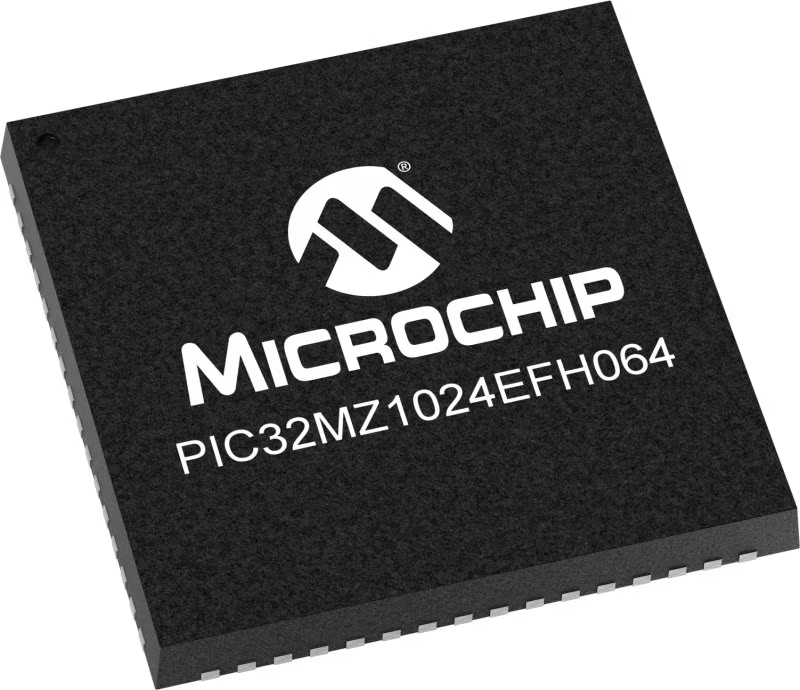
建筑
PIC32
MCU 内存 (KB)
1024
硅供应商
Microchip
引脚数
64
RAM (字节)
524288
使用的MCU引脚
mikroBUS™映射器
“仔细看看!”
Click board™ 原理图

一步一步来
项目组装
实时跟踪您的结果
应用程序输出
1. 应用程序输出 - 在调试模式下,“应用程序输出”窗口支持实时数据监控,直接提供执行结果的可视化。请按照提供的教程正确配置环境,以确保数据正确显示。

2. UART 终端 - 使用UART Terminal通过USB to UART converter监视数据传输,实现Click board™与开发系统之间的直接通信。请根据项目需求配置波特率和其他串行设置,以确保正常运行。有关分步设置说明,请参考提供的教程。

3. Plot 输出 - Plot功能提供了一种强大的方式来可视化实时传感器数据,使趋势分析、调试和多个数据点的对比变得更加直观。要正确设置,请按照提供的教程,其中包含使用Plot功能显示Click board™读数的分步示例。在代码中使用Plot功能时,请使用以下函数:plot(insert_graph_name, variable_name);。这是一个通用格式,用户需要将“insert_graph_name”替换为实际图表名称,并将“variable_name”替换为要显示的参数。

软件支持
库描述
该库包含 Fingerprint 4 Click 驱动程序的 API。
关键功能:
fingerprint4_version- 此函数从设备读取版本信息fingerprint4_identify_finger- 此函数捕捉并识别与Flash存储中的现有模板匹配的指纹fingerprint4_wait_finger_not_present- 此函数等待传感器上没有检测到指纹
开源
代码示例
完整的应用程序代码和一个现成的项目可以通过NECTO Studio包管理器直接安装到NECTO Studio。 应用程序代码也可以在MIKROE的GitHub账户中找到。
/*!
* @file main.c
* @brief Fingerprint 4 Click example
*
* # Description
* This example demonstrates the use of the Fingerprint 4 Click boards by registering 3 fingerprints and
* then waiting until a finger is detected on the sensor and identifying if the fingerprint matches one of
* those stored in the Flash storage.
*
* The demo application is composed of two sections :
*
* ## Application Init
* Initializes the driver and reads the sensor firmware version, then resets the sensor and removes all
* stored fingerprint templates. After that it registers 3 new fingerprint templates and stores them in the Flash storage.
*
* ## Application Task
* Waits until a finger is detected on the sensor, takes an image of the finger and checks if there's
* a fingerprint in the library that matches the one it has just read. If it finds a match, a fingerprint template
* ID will be displayed. All data is being logged on the USB UART where you can track the program flow.
*
* @author Stefan Filipovic
*
*/
#include "board.h"
#include "log.h"
#include "fingerprint4.h"
#define LOCATION_IN_FLASH 0 // Starting location or template ID where the fingerprints will be stored.
#define NUMBER_OF_FINGERPRINTS 3 // Number of fingerprints to register.
static fingerprint4_t fingerprint4;
static log_t logger;
/**
* @brief Fingerprint 4 error check function.
* @details This function checks the @b error_flag and displays the result appended to @b message
* on the USB UART.
* @param[in] message : Prefix message of the error_flag result.
* @param[in] error_flag : Error flag, return value of the functions.
* @return None.
* @note None.
*/
static void fingerprint4_error_check ( char *message, err_t error_flag );
/**
* @brief Fingerprint 4 enroll fingerprint function.
* @details This function enrolls a single fingerprint by taking 3 image captures. Each step will be logged on the USB UART
* where you can track the function flow.
* @param[in] ctx : Click context object.
* See #fingerprint4_t object definition for detailed explanation.
* @return @li @c 0 - Success,
* @li @c <0 - Error.
* See #fingerprint4_return_value_t definition for detailed explanation.
* @note None.
*/
static err_t fingerprint4_enroll_fingerprint ( fingerprint4_t *ctx );
/**
* @brief Fingerprint 4 register fingerprints function.
* @details This function registers a desired number of fingerprints starting from the selected template ID.
* Each step will be logged on the USB UART where you can track the function flow.
* @param[in] ctx : Click context object.
* See #fingerprint4_t object definition for detailed explanation.
* @param[in] template_id : Starting template ID of fingerprints to store to Flash.
* @param[in] num_fpc : Number of fingerprints to register.
* @return None.
* @note None.
*/
static void fingerprint4_register_fingerprints ( fingerprint4_t *ctx, uint16_t template_id, uint8_t num_fpc );
void application_init ( void )
{
log_cfg_t log_cfg; /**< Logger config object. */
fingerprint4_cfg_t fingerprint4_cfg; /**< Click config object. */
/**
* Logger initialization.
* Default baud rate: 115200
* Default log level: LOG_LEVEL_DEBUG
* @note If USB_UART_RX and USB_UART_TX
* are defined as HAL_PIN_NC, you will
* need to define them manually for log to work.
* See @b LOG_MAP_USB_UART macro definition for detailed explanation.
*/
LOG_MAP_USB_UART( log_cfg );
log_init( &logger, &log_cfg );
log_info( &logger, " Application Init " );
// Click initialization.
fingerprint4_cfg_setup( &fingerprint4_cfg );
FINGERPRINT4_MAP_MIKROBUS( fingerprint4_cfg, MIKROBUS_1 );
if ( FINGERPRINT4_RES_OK != fingerprint4_init( &fingerprint4, &fingerprint4_cfg ) )
{
log_error( &logger, " Communication init." );
for ( ; ; );
}
fingerprint4_reset_device ( &fingerprint4 );
fingerprint4.phy_rx_timeout = FINGERPRINT4_DEFAULT_PHY_RX_TIMEOUT_MS;
uint8_t version[ 50 ] = { 0 };
if ( FINGERPRINT4_RES_OK == fingerprint4_version ( &fingerprint4, version, 50 ) )
{
log_printf( &logger, " FW version: %s\r\n", version );
log_printf( &logger, "---------------------------------\r\n\n" );
}
fingerprint4_error_check( "Sensor reset", fingerprint4_sensor_reset ( &fingerprint4 ) );
fingerprint4_error_check( "Remove all templates", fingerprint4_template_remove_all ( &fingerprint4 ) );
fingerprint4_register_fingerprints ( &fingerprint4, LOCATION_IN_FLASH, NUMBER_OF_FINGERPRINTS );
log_info( &logger, " Application Task " );
}
void application_task ( void )
{
uint16_t template_id;
bool match;
log_printf( &logger, " Put your finger on the sensor.\r\n" );
err_t error_flag = fingerprint4_identify_finger ( &fingerprint4, FINGERPRINT4_INFINITE_TIMEOUT, &template_id, &match );
if ( error_flag )
{
fingerprint4_error_check( "Identify finger", error_flag );
}
else
{
if ( match )
{
log_printf( &logger, " >>>>> Fingerprint MATCH - Template ID: %u <<<<<\r\n", template_id );
}
else
{
log_printf( &logger, " >>>>> NO MATCH in the library <<<<<\r\n" );
}
}
log_printf( &logger, " Lift the finger of the sensor.\r\n" );
fingerprint4_wait_finger_not_present ( &fingerprint4, FINGERPRINT4_INFINITE_TIMEOUT );
log_printf( &logger, "---------------------------------\r\n\n" );
}
int main ( void )
{
/* Do not remove this line or clock might not be set correctly. */
#ifdef PREINIT_SUPPORTED
preinit();
#endif
application_init( );
for ( ; ; )
{
application_task( );
}
return 0;
}
static void fingerprint4_error_check ( char *message, err_t error_flag )
{
log_printf( &logger, " %s: ", message );
if ( error_flag )
{
log_printf( &logger, "FAIL! [ERROR] Num: %ld\r\n", error_flag );
}
else
{
log_printf( &logger, "DONE!\r\n" );
}
log_printf( &logger, "---------------------------------\r\n\n" );
}
static void fingerprint4_register_fingerprints ( fingerprint4_t *ctx, uint16_t template_id, uint8_t num_fpc )
{
err_t error_flag = FINGERPRINT4_RES_OK;
uint8_t cnt = 1;
while ( cnt <= num_fpc )
{
log_printf( &logger, " >>> Registering fingerprint %u of %u <<<\r\n", ( uint16_t ) cnt,
( uint16_t ) num_fpc );
error_flag = fingerprint4_enroll_fingerprint ( ctx );
if ( error_flag )
{
fingerprint4_error_check( "Enroll finger", error_flag );
}
else
{
error_flag = fingerprint4_template_save ( &fingerprint4, template_id + cnt - 1 );
if ( error_flag )
{
fingerprint4_error_check( "Template save", error_flag );
}
else
{
log_printf( &logger, " Fingerprint template ID: %u\r\n", template_id + cnt - 1 );
log_printf( &logger, "---------------------------------\r\n\n" );
cnt++;
}
}
}
}
static err_t fingerprint4_enroll_fingerprint ( fingerprint4_t *ctx )
{
err_t error_flag = FINGERPRINT4_RES_OK;
bool enroll_done = false;
// Enroll start
error_flag = fingerprint4_send_cmd ( ctx, FINGERPRINT4_CMD_ENROLL, FINGERPRINT4_ARG_START );
if ( error_flag )
{
fingerprint4_error_check( "Enroll start", error_flag );
return error_flag;
}
uint8_t cnt = 1;
while ( cnt <= FINGERPRINT4_NUM_IMAGES )
{
log_printf( &logger, " >>> Taking image %u of %u <<<\r\n", ( uint16_t ) cnt,
( uint16_t ) FINGERPRINT4_NUM_IMAGES );
log_printf( &logger, " Put your finger on the sensor.\r\n" );
// Capture image
uint32_t prev_timeout = ctx->phy_rx_timeout;
ctx->phy_rx_timeout = FINGERPRINT4_INFINITE_TIMEOUT;
error_flag = fingerprint4_send_cmd_arg ( ctx, FINGERPRINT4_CMD_CAPTURE, FINGERPRINT4_ARG_NONE,
FINGERPRINT4_ARG_TIMEOUT, &ctx->phy_rx_timeout, sizeof ( ctx->phy_rx_timeout ) );
ctx->phy_rx_timeout = prev_timeout;
if ( error_flag )
{
fingerprint4_error_check( "Capture image", error_flag );
continue;
}
// Enroll add
error_flag = fingerprint4_send_cmd ( ctx, FINGERPRINT4_CMD_ENROLL, FINGERPRINT4_ARG_ADD );
if ( error_flag )
{
fingerprint4_error_check( "Enroll add", error_flag );
continue;
}
cnt++;
uint32_t samples_remaining;
fingerprint4_copy_arg ( ctx, FINGERPRINT4_ARG_COUNT, ( uint8_t * ) &samples_remaining, 4 );
// Break enrolling if we collected enough correct images
if ( !samples_remaining )
{
enroll_done = true;
break;
}
log_printf( &logger, " Lift the finger of the sensor.\r\n" );
log_printf( &logger, "---------------------------------\r\n" );
fingerprint4_wait_finger_not_present ( ctx, FINGERPRINT4_INFINITE_TIMEOUT );
}
error_flag = fingerprint4_send_cmd ( ctx, FINGERPRINT4_CMD_ENROLL, FINGERPRINT4_ARG_FINISH );
if ( error_flag )
{
fingerprint4_error_check( "Enroll finish", error_flag );
return error_flag;
}
log_printf( &logger, " Lift the finger of the sensor.\r\n" );
log_printf( &logger, "---------------------------------\r\n" );
fingerprint4_wait_finger_not_present ( ctx, FINGERPRINT4_INFINITE_TIMEOUT );
return ( !enroll_done ) ? FINGERPRINT4_RES_ERROR : error_flag;
}
// ------------------------------------------------------------------------ END



















